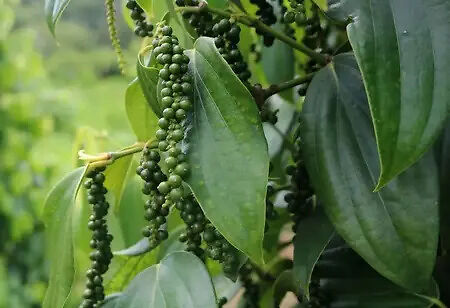
The King of Spices: Know All about Pepper Farming


While traveling to coastal Karnataka through the beautiful hill Agumbe (Western ghats), which is also known as the second Cherrapunjee of India, you will find plantations covering both sides of the road throughout the foothills. If you watch closely, you can see that the plants are covered with the climbers. They are not simply climbers but pepper plants, the king of spices. In the olden days, Pepper, one of the main ingredients in traditional cooking, was usually grown in the forest. Villagers used to go to the forest of Agumbe hills and collect the pepper. But over time, the crop's demand increased, alongside the broad prospects applications, such as medicinal and commercial. People started depending on the pepper plantation.
The pepper plant is a perennial climber, which is usually grown with the support of other plants like coconut, areca nut trees, etc. A seasonal spice (June-December) that belongs to the Piperaceae family, it is one of the earliest spices the world knows. In India, Karnataka is the highest producer of pepper. As the crop requires more water, it is usually grown in the west coastal area of Karnataka. The region is well known for people who are full-time pepper farmers.
Satyanarayana Udupa, a farmer in Hunsemakki village of Udupi district, has grown pepper vines on 600 areca nut, coconut, and mango trees, in his field. Last year, he reaped 80 kilograms of black pepper. He says labor involvement is little needed to grow pepper. There are hundreds of farmers in the region just like him.
Here are some resources and measures to follow to grow pepper:
Soil and Climate
Pepper consumes more water to grow, continuous supply of water is necessary for this crop. It requires heavy rainfall of 150 to 200 cm, and the climate should be warm as well as humid.
The soil should be abundant in humus. If the crop gets enough nutrition to grow, it can be grown to elevations up to 1500 m. The best season to grow the plant is between June to December. In 2021, due to climate changes, farmers saw a dip in production.
Irrigation
Irrigation is one of the most important aspects of pepper farming. The crop should be supplied with a proper water source between December to May with an interval of 10 Days.
Propagation
Pepper grows with three aerial shoots:
- Primary with long internodes, adventitious roots with clings on the standards.
- Runner shoots that originated from the mother vein
- Fruit-bearing lateral shoots
Usually, cuttings are often done in the runner shoots for hybridization. The crops can also be grown in bushy bunches.
There are different methods to cut the shoots in order to increase the yield, and the horticulture department guides the farmers to grow the crop. Pepper is propagated vegetatively from cuttings.
Propagation through Traditional Methods
The running shoots exposed from the vine coiled on the wooden pegs should be prevented from touching the soil and the base of the vine. During February or March, the running shoots should be separated from the mother vine. They can be cut into two to three pieces of shoots and planted in polythene bags having enough fertilizer. The cuttings will be ready for planting in May - June month. It is the easiest way to grow pepper plants. Now hybrid methods like multiplication and trench and serpentine methods are followed in the nurseries to grow pepper plants.
How should we Plant the Propagated Buds from the Vein
Pits should be gigged in a cubical shape with a one to three-meter distance. The pit should be filled with five to 10 kgs of manure. And the veins that are propagated can be planted in the pits.
Manure Required for Pepper Plant
Cattle manure or compost is the best fertilizer for pepper. So a vine requires 10 kg of manure in the West monsoon. During May–June, and September–October, 100 g of N, 40 g of P, and 140 g of K per vine should be applied in two split doses. During May–June, in the alternate year, 500 grams of slaked lime can be applied to each vine. The manure should be supplied 30 cm from the base and incorporated into the soil.
Weeding
Two weddings can be done in June and in December. Vines should be trained to grow by standards, and 40 ppm NAA- Naphthalene acetic acids can be sprayed to increase the size of the berries. And spike shedding also can be reduced by spraying one percent phosphate spraying before the flower initiates. It can be sprayed before the spike initiation and during the pinhead stage of berries.
Initiatives by Horticulture Department
The horticulture department provided free 1000 veins for farmers of Karkala Taluk, and the mission was to promote the cultivation of pepper in the District. A subsidy of 20,000 per hectare was also given to the farmers to grow the pepper on their farms. Department also provided pesticides to treat the wilt diseases that are usually seen in the pepper plants. The Horticulture department also organized training programs for the farmers to create awareness about spike shedding and wilt disease.
The farmers who attended the training programs are happy with the production and are getting more markets to sell the crop.